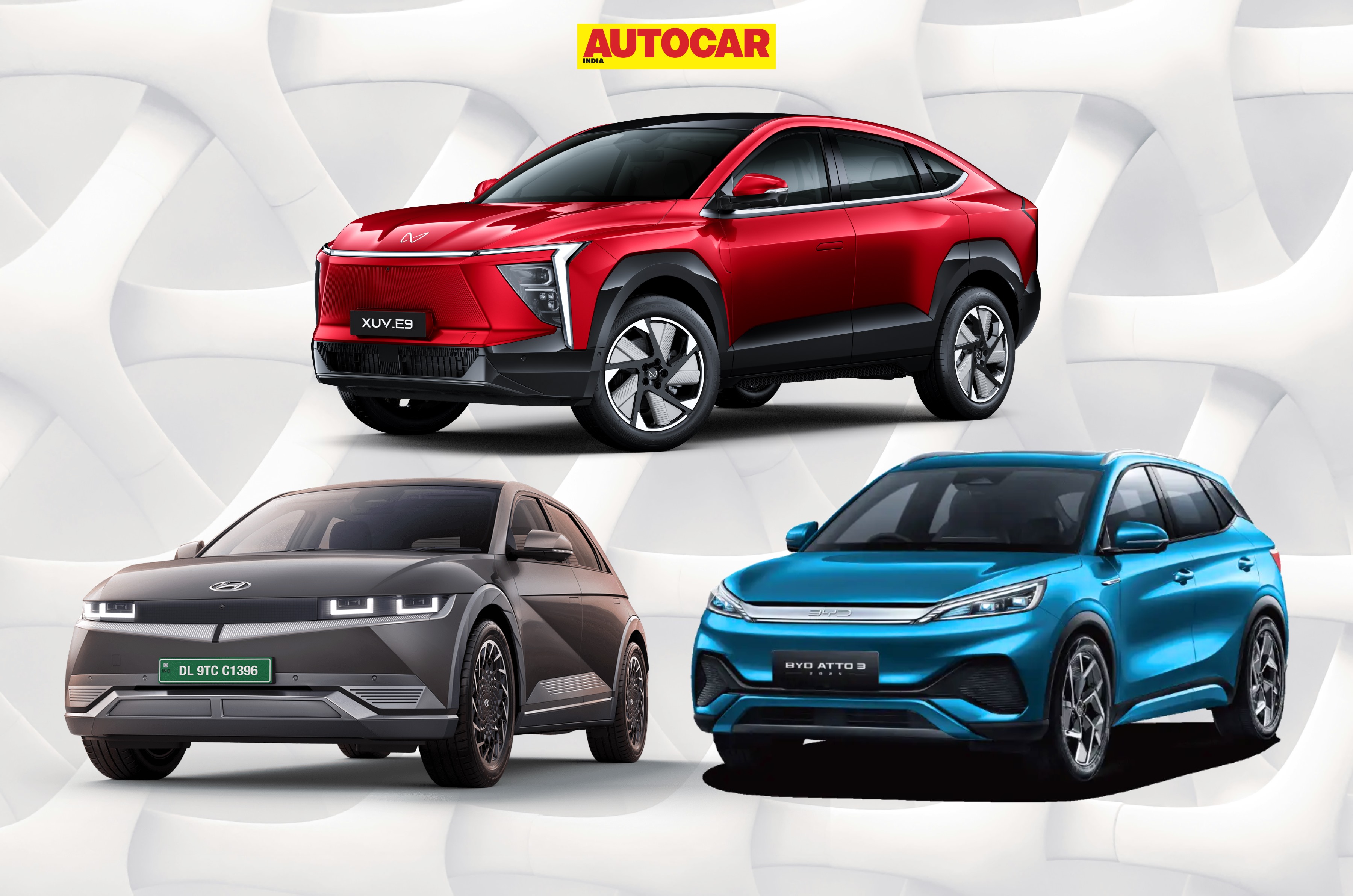
Mahindra has revealed the first of its born-EVs – the BE 6e and the XEV 9e. While the smaller BE already has competition in the market (from the Tata Curvv EV and MG ZS EV) and more than a few upcoming rivals (from Maruti’s e Vitara to the Hyundai Creta EV), the larger XEV 9e is a somewhat more niche model.
The all-electric coupe-SUV is not expected to see any direct competition until Tata brings out the Harrier EV next year. However, based on its price, size and specifications, along with the fact that's it's a born-EV and not an ICE conversion, the XEV 9e will contend with the BYD Atto 3 and the Hyundai Ioniq 5, to a degree.
Mahindra XEV 9e vs rivals size
| Mahindra XEV 9e vs rivals: Dimensions | |||||
|---|---|---|---|---|---|
| XEV 9e | Atto 3 | Ioniq 5 | |||
| Length (mm) | 4789 | 4455 | 4635 | ||
| Width (mm) | 1907 | 1875 | 1890 | ||
| Height (mm) | 1694 | 1615 | 1625 | ||
| Wheelbase (mm) | 2775 | 2720 | 3000 | ||
| Ground clearance (mm) | 207 | 175 | 163 (laden) | ||
| Turning diameter (m) | 10 | - | 12 | ||
| Tyres | 245/55 R19 (245/50 R20) | 215/55 R18 | 255/45 R20 | ||
| Boot (litres) | 663 | 440 | 527 | ||
| Frunk (litres) | 150 | - | 57 | ||
Among the XEV 9e, Atto 3 and Ioniq 5, it is the Mahindra that is the largest overall by a fair margin, though the Hyundai has the longest wheelbase; it's a whopping 225mm longer than the XEV and 280mm longer than the BYD. From wheel size to boot space, the Atto 3 is the smallest e-SUV here and doesn't get a frunk either.
Mahindra claims that its variable ratio steering helps reduce the turning radius, which is one reason why the larger Mahindra has a smaller diameter than the Hyundai. The Ioniq 5 has the largest wheels with the widest tyres here, but Mahindra does offer a comparable size as an optional extra. Finally, the Mahindra's boot space and frunk capacity are the largest here.
Mahindra XEV 9e vs rivals range, battery, charging
| Mahindra XEV 9e vs rivals: Battery, range, charging | |||||
|---|---|---|---|---|---|
| XEV 9e 59kWh | XEV 9e 79kWh | Atto 3 Dynamic | Atto 3 Premium & Superior | Ioniq 5 | |
| Battery size (kWh) | 59 | 79 | 49.92 | 60.48 | 72.6 |
| Motor (hp/Nm) | 231/380 | 286/380 | 204/310 | 204/310 | 217/350 |
| Drive | RWD | RWD | FWD | FWD | RWD |
| MIDC range (km) | 542 | 656 | 468 | 521 | 631 |
| Fast charging (min) | 20 (140kW) | 20 (170kW) | 50 (50kW) | 50 (50kW) | 21 (150kW) |
| Charging (hours) | 8.7 (7.2kW), 6 (11kW) | 11.7 (7.2kW), 8 (11kW) | 8 | 9.5-10 | 7 (11kW) |
| Claimed 0-100kph (seconds) | - | 6.8 | 7.9 | 7.3 | 7.6 |
The XEV 9e and the Atto 3 are available with two battery pack options, while the Ioniq 5 has just one. When comparing the entry level BYD and Mahindra, one can see that the XEV gets a larger battery with more range, and a more powerful motor. In fact, the higher-spec Atto 3 is more comparable to the entry-level XEV 9e in terms of range, battery size and charging times.
The higher-spec XEV 9e, with the 79kWh battery seems to outdo the Ioniq 5, on paper, on every performance metric, from range to 0-100kph and charging times. Interestingly, even the larger battery Atto 3 is quicker to sprint to 100kph than the Ioniq 5. It should be noted that the Mahindra and Hyundai are rear-wheel drive models, while the BYD is front-wheel drive.
Mahindra XEV 9e vs rivals price
| Mahindra XEV 9e vs rivals: Price, ex-showroom, India (in Rs, lakh) | |||
|---|---|---|---|
| XEV 9e | Atto 3 | Ioniq 5 | |
| Price range | Rs 21.90 lakh onwards | Rs 24.99-33.99 lakh | Rs 46.05 lakh |
While the Rs 21.90 lakh base price tag for the XEV 9e is extremely competitive – undercutting the BYD Atto 3's entry-level price by over Rs 3 lakh, and the Hyundai Ioniq 5's by a massive Rs 24.05 lakh – it should be noted that this is an introductory price that will increase in the coming months. In addition, the Mahindra's price tag does not inlcude the price of the charger or the installation of one, while the other two's price includes the cost.
Nonetheless, on paper, the Mahindra XEV 9e seems to have a definite advantage over its born-EV rivals. It is priced lower, gets more range and performance, and is larger as well, which bodes well for the space offered on the inside.
Also see: